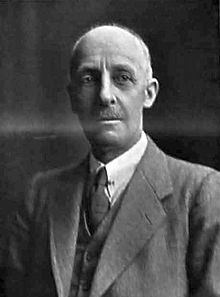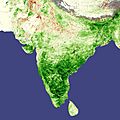Gilbert Walker para niños
Datos para niños Gilbert Walker |
||
|---|---|---|
 |
||
| Información personal | ||
| Nacimiento | 1868 Rochdale, Lancashire |
|
| Fallecimiento | 1958, 90 años Coulsdon, Surrey |
|
| Residencia | Inglaterra, India | |
| Nacionalidad | británico | |
| Educación | ||
| Educado en |
|
|
| Información profesional | ||
| Área | profesor, físico, climatólogo, meteorólogo, estadístico | |
| Conocido por | Oscilaciones climáticos El Niño | |
| Cargos ocupados | Presidente (1926-1927) | |
| Empleador | Escuela Imperial de Londres | |
| Miembro de | Royal Society | |
| Distinciones | Miembro de la Royal Society Premio Adams (1899) Medalla de Oro Symons (1934) |
|
Gilbert Thomas Walker (14 de junio de 1868 – 4 de noviembre de 1958) fue un científico británico muy importante. Fue profesor, físico, climatólogo, meteorólogo y estadístico. Es famoso por describir cómo el clima cambia en diferentes partes del mundo, lo que ayudó a entender fenómenos como El Niño.
Sus descubrimientos fueron un gran avance para el estudio del clima global. Gracias a él, los científicos pudieron empezar a ver el clima de la Tierra como un sistema conectado.
Contenido
¿Quién fue Gilbert Walker?
Gilbert Walker nació en 1868 en Rochdale, Lancashire, Inglaterra. Fue el cuarto de siete hijos de Thomas Walker y Charlotte Haslehurt. Desde joven, mostró un gran interés por las matemáticas y la ciencia.
Sus primeros años y estudios
Walker estudió en la escuela St Paul's en West Kensington. Luego, ingresó al Trinity College en Cambridge, una de las universidades más prestigiosas. Allí, se destacó mucho en matemáticas, obteniendo el título de Senior Wrangler en 1889. Este título se le daba al estudiante con las mejores calificaciones en matemáticas. En 1895, se convirtió en profesor en el Trinity College.
Descubriendo los secretos del clima en la India
En 1904, Gilbert Walker se convirtió en el director general de observaciones meteorológicas en la India. En ese momento, la India sufría mucho por las sequías, especialmente una muy grave en 1899 causada por la falta del monzón.
Su misión era entender mejor el clima de la India para predecir estos eventos. Durante quince años, Walker analizó una enorme cantidad de datos sobre el clima de la India y sus alrededores.
¿Qué es la Oscilación del Sur?
Gracias a su trabajo, Walker descubrió algo asombroso: las grandes variaciones en la presión del aire entre la India y el Océano Pacífico. A esto lo llamó la Oscilación del Sur. Se dio cuenta de que cuando la presión subía en un lugar, bajaba en el otro, y viceversa.
Además, encontró que estos cambios en la presión estaban relacionados con los patrones de temperatura y lluvia en muchas regiones tropicales del planeta, incluyendo la India. Fue una idea revolucionaria porque conectaba el clima de lugares muy lejanos.
El Niño y su conexión
Los estudios de Walker fueron clave para entender un fenómeno climático muy importante llamado El Niño. El Niño es un cambio en la temperatura del océano Pacífico que afecta el clima en todo el mundo, causando sequías en algunos lugares y lluvias intensas en otros. La Oscilación del Sur que descubrió Walker es una parte fundamental de este fenómeno.
Un legado para la ciencia del clima
Gilbert Walker se retiró de su puesto en la India en 1924. Sin embargo, continuó sus investigaciones sobre el clima y el cambio climático. Fue reconocido por su trabajo y obtuvo una cátedra de meteorología en el Imperial College London.
Sus teorías y las extensas investigaciones que realizó fueron un paso gigante para la ciencia del clima. Su trabajo permitió a los científicos ir más allá de observar el clima local. Gracias a él, pudieron empezar a crear modelos climáticos complejos que simulan el clima de todo el planeta.
Gilbert Walker falleció en Coulsdon, Surrey, el 4 de noviembre de 1958, a la edad de 90 años.
Galería de imágenes
Véase también
 En inglés: Gilbert Walker (physicist) Facts for Kids
En inglés: Gilbert Walker (physicist) Facts for Kids


